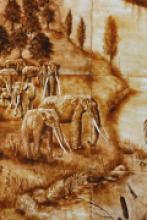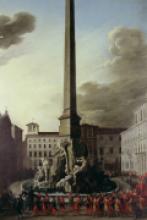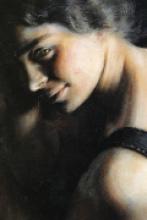The Artwork of the Month - July 2022
Angelo Morbelli
(Alessandria, 1853 - Milano, 1919)
In Giardino - Angolo di giardino, 1912
Oil on canvas, 46 x 71 cm
inv. AM 60

From a sunny clearing, bordered on the left by trees and bushes, the view opens up to a rural landscape with trees and roads among the vineyards. The painting depicts a corner of the domestic garden of Angelo Morbelli's house in Colma di Rosignano, Monferrato. The compositional choice and the point of view emphasise the shaped shrubs on the left, elements designed to scan the different planes of space and suggest the depth of perspective; on the wide, close-up foreground, the shadows of the trees are suggestively cast, which we can sense off-screen.
Angelo Morbelli is one of the main exponents of Italian Divisionism. Trained at the Brera Academy of Fine Arts under the guidance of Giuseppe Bertini, he made his debut with a verist style of painting; from 1888, with Segantini, Previati, Ranzoni and Cremona, he delved into Rood's theory of colours and produced his first Divisionist paintings. The conscious use of complementary colours and the quick, punctiform brushstrokes enabled him to achieve a brilliant and luminous painting, capable of rendering tonal and luminous variation in a meticulous manner. From 1894, thanks to his friendship with Pellizza da Volpedo, Morbelli's technical and scientific research deepened further, combining it with subjects with a strong social and political content. In the early 20th century, Symbolist themes finally take over, including the scenes painted at the hospice of the pio Albergo Trivulzio in Milan, a heartfelt transcription of the 'poem of old age' and illness.
The landscape accompanies Morbelli's entire career, whose production is rich in gardens, country views, mountains and seascapes. These are pure landscapes, usually without figures, in which, as in this case, close-ups and the geometric scanning of volumes in depth are accentuated. The Divisionist technique is an acute tool for the investigation of reality, light and colour in all its nuances; through its application, every part of the painting is unified by the dense network of brushstrokes, which render a minute, continuous and pulviscular texture, in a warm pinkish colour dominant. Morbelli used to start from a sketch made en plein air and then reworked it in the studio in a slow and meticulous manner, sometimes with the aid of coloured glass, carefully studying the tones, shadows and chiaroscuro.
The work was purchased by the City of Rome in 1913, on the occasion of the LXXXII Esposizione di Belle Arti della Società Amatori e Cultori. Two other versions of the painting are in the Pinacoteca di Bari and the Civica Galleria d'Arte Moderna in Novara. In those years (1912-17) Morbelli was also busy writing a series of notes and reflections on painting, an artistic and personal diary entitled La via crucis del divisionismo.
Return to the section > The Galleria d'Arte Moderna artwork of the month







































